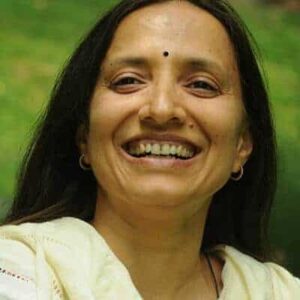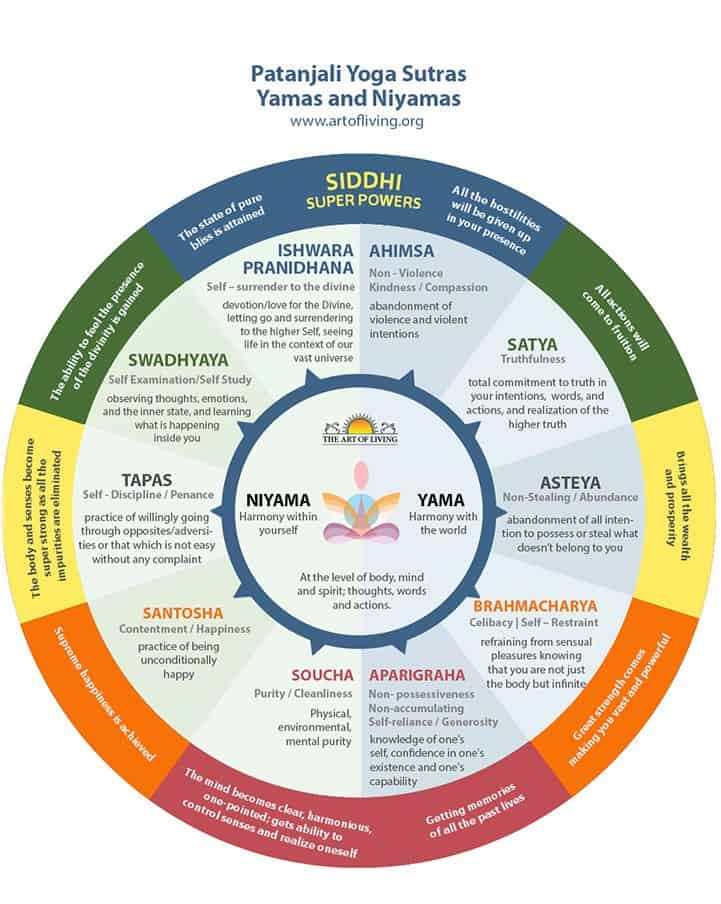Clearing Misconceptions about Yamas and Niyamas
The yamas and niyamas are not commandments from on high to follow because we’re afraid of what will happen if we don’t follow them. On the contrary, I see them as practical ways to live life so we can access inner peace, bliss, and love in our day-to-day life, not just momentarily but 24/7. Maybe that is what we can call self-realization or enlightenment.
The practice of the yamas and niyamas definitely inspires us to remember that yoga is a way of life—not just something we do for 90 minutes three times a week on a rectangular yoga mat. In fact, if they are interwoven in every fabric of our life, every moment becomes sadhana (spiritual practice). They add the necessary juice to our practice. Without them, the rest of the eight limbs may become empty, mechanical and boring techniques.
The late Dr. B. K. S. Iyengar described both the yamas and niyamas as the ‘golden keys to unlock the spiritual gates,’ as they transform each action into one that originates from a deeper and more ‘connected’ place within ourselves. From that state of being, we move closer towards wholeness, connectedness, and unity, and start to not just ‘do’ yoga, but live and breathe ‘yoga’ in each and every moment.
We all desire to have the benefits of practicing these ten guidelines or observances. But the benefits are often intangible. In our rush to get on the mat, get moving, and get noticeable and tangible results, we may not spend enough time to understand them, practice them, and gauge their benefits correctly.
How to Approach the Yamas and Niyamas in Daily Life
There is one approach which sees the eight limbs as steps, and it can lead us to believe that until we follow and master the yamas and niyamas, we cannot practice other limbs and get benefit out of their practice. This approach may raise many self-doubting questions, such as
- How can we calm the mind in meditation, when it is full of anger and discontentment?
- How can we experience the stillness in the posture if we are not ready for tapas (penance)?
- How can we enjoy the relaxation in savasana if we are not prepared to let go and surrender?
- How can we go deeper into our breath when our body and surroundings are not clean (saucha) enough?
Explaining the second approach, Gurudev Sri Sri Ravi Shankar, the world-renowned spiritual leader, who is my role model and example of a perfect yogi says, “Yoga has eight limbs, like a chair which has four legs. Each one is connected to the whole. If you pull one leg, the whole chair comes. When the body is developing, the whole body develops together. All the organs of the body develop together. Not that the nose develops first and then the ears come; all the aspects, all the limbs of the body develop simultaneously. That is why Patanjali says that these are all the limbs (not steps) of yoga and they develop simultaneously.”
This understanding, that these eight aspects of yoga are not steps but limbs that grow simultaneously, removes all self doubt and gives us so much space, freedom, and enthusiasm to practice yoga as a whole with a full heart.
“Yoga anga anushtanat ashuddhi kshaye jnanadi Apthiraviveka khyatehe’’ (Sutra II—28)
“By the sustained practice of the eight limbs of yoga, the impurities are destroyed and the light of wisdom, discrimination shines forth.”
Explaining this sutra, Gurudev Sri Sri Ravi Shankar says, “Human consciousness is like a seed. A seed has the possibility of a tree, of the leaves, of a branch, of fruits, of flowers, of multiplication; so also the human mind. A seed needs a proper ground, proper conditions, sunlight, water, proper soil for it to sprout and blossom. Similarly human consciousness and human mind. Either the seed can be dormant for years, keeping its possibility within itself, or it starts blossoming, sprouting. The sprouting of the seed of human consciousness is viveka – discrimination. Freedom comes with viveka – discrimination.”
With this I understand that one need not master the 1st or 2nd limb of yoga in order to learn the 3rd to 8th limbs of yoga. All eight limbs can be practiced simultaneously. And when we practice all eight limbs together, we have the possibility to fully blossom our human potential. With practice of eight limbs of yoga, the freedom that comes from discrimination dawns in you.
He further says, “To the extent you practice yamas and niyamas, you will go deeper into your practice and purpose of yoga. There is no need to doubt or analyze yourself too much. Just the intention to practice yamas and niyamas is good enough. Just sow the seeds, keep nurturing them with your practice, and relax. The seeds will sprout.”
This is so empowering. With this approach I find that it becomes easy to make the yamas and niyamas an ingrained part of my daily habits; it motivates me that it is easy to cultivate a full and fulfilling yama/niyama practice in our modern life, without going to the Himalayas.
Practice, Practice, and Practice—with Reverence is the Way
Our on the mat practices of asana, pranayama (breathing exercises), and meditation will help us calm the mind and increase self-awareness and thus will help with practice of yama and niyama too.
Learn more about yamas and niyamas at 200H Sri Sri Yoga Teacher Training.






